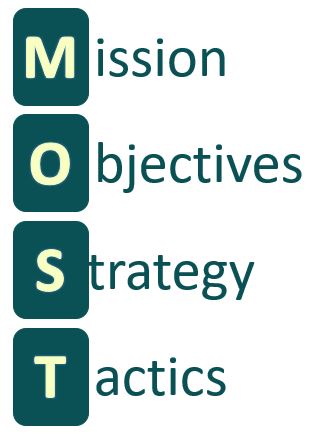Most experienced business analysts come equipped with skills in strategy analysis – but are rarely invited to use them! In this post, I look at how BAs can apply these tools and techniques to add value at all stages of a project by establishing a ‘golden thread’ from the organisation’s highest-level goals down to the detail of requirements specifications.

The main BA qualification route for business analysts here in the UK is the BCS International Diploma in Business Analysis. Its compulsory module on Business Analysis Practice features several elements of strategy analysis; BAs learn a bunch of principles and techniques they can apply to understand what an organisation aims (or should be aiming) to achieve. These include MOST analysis, SWOT, PESTLE, resource audit, and Porter’s Five Forces. If they purchase the BCS Business Analysis book, they’ll find a whole chapter on strategy analysis.
Back in the real world, many business analysts will find themselves wondering if they’ll ever be invited to use these tools. According to IIBA UK’s 2020 survey of business analysts, almost one in ten responded that they wanted to be working in Strategic Management in 5 years’ time. However, fewer than 20% thought strategy analysis was part of their core offering to their organisation, and around a third said they currently never got involved in it at all.
So when do we get to show the world what we can do?
I believe that as BAs, we can help organisations unlock greater value by considering strategy at all stages of a change initiative or project. This creates a “golden thread” from the organisation’s strategic goals all the way down to detailed requirements or process design. Ensuring the problem is understood in the context of the organisation’s strategy, making sure the solutions chosen are the best fit with strategic goals, and defining requirements for features and capabilities that help deliver on those goals.
Consider the organisation’s strategy when exploring the problem space
Organisations of different types may have vastly differing strategic goals. A major insurer will want to achieve very different things to a charity, or to an educational institution. When exploring a new problem domain, it’s essential to understand what the organisation wants to be, what it wants to achieve (better patient outcomes, or improving profitability for example), and how it intends to get there. It’s not enough to know that something is a ‘gap’ – you want to discover why it qualifies as such.
See what you can identify about the organisation’s strategic thinking and plans. There may be information shared in the public domain, or communicated internally via newsletters, announcements or on an intranet. Your senior stakeholders are likely to have the greatest knowledge of the organisation’s goals and strategic intent.
Identify any mismatch between stakeholders’ perspectives on the organisation’s strategy. This is a chance to finally use ‘CATWOE’ analysis!
I like to deploy a bit of ‘MOST’ analysis. The simple part is generally seeking out the top-level mission and objectives. These are likely to have been published somewhere. It’s the next levels down – the strategies and tactics – that are more challenging to uncover. When I learned this analysis technique, it was suggested that we consider the ‘S’ as chosen behaviour patterns. These might include pursuing bleeding-edge technology, selling more to existing customers, or supporting the development of talent internally.

The ‘T’ in this technique (the tactics) are the tangible and finite actions that will be undertaken. These might include the development of a new product, a move into a new market, or enacting a change to a department’s structure. Problem analysis is essential to determining whether a tactical change will be required to deliver on the strategy.
Strategic behaviour patterns and tactical moves all require the bridging of a gap between the current and future states; examining them provides an essential context for any business problem or opportunity.
As a general point, I find it helpful to be very up-front that you’re talking about strategy. State clearly “this is what I understand about the organisation’s strategic intent”. It will inevitably attract lively debate – particularly in the amorphous layer of strategy definition and organisational planning that sits below mission statements and objectives. Elements of the organisation’s strategy may not yet be clearly defined, and may only exist in the heads of key stakeholders. It is far better to draw out disagreement before implementing changes than discovering them after time and money has been spent delivering a project!
Evaluate the potential solutions for their strategic fit
Consider resource audit – looking at the internal human, financial, and physical resources the organisation can bring to bear to deliver and use the solution. Are there gaps that make some solutions more appropriate than others? Does a solution require specialist skills to implement that aren’t currently available? If there are tight financial constraints, an expensive off-the-shelf solution may be beyond the means of the organisation – but perhaps it enables savings that will drastically improve profitability in the future!
Think about what strategic behaviours the organisation intends to deploy – for example, making better use of property assets, or pursuing lean processes. Are these behaviours reflected in the proposed solutions? Which solutions fit most neatly?

Think about external factors (PESTLE is obviously great for this!) and how they may affect the suitability of a solution. There may be emerging risks on the horizon that will need to be factored into decision making.
View detailed requirements and process design through a strategic lens

Having established that a particular change or solution is the right one to pursue, it’s important to follow the ‘golden thread’ through to the detail or process design and technology requirements. When considering these it’s easy to be swayed by arguments that a particular feature will bring a great deal of value – but it’s vital to consider whether this ‘value’ is the kind the organisation is actually seeking. An automated process step isn’t necessarily useful if the organisation is seeking to maximise meaningful touchpoints with customers.
Understanding the organisation’s strategic intent – and being able to effectively articulate this to stakeholders – is key to facilitating those tricky discussions around what’s going to be in or out of scope, or what needs to be in the next sprint. If delighting customers is a key strategic aim, then techniques such as Kano analysis can be great for initiating conversations around minimum customer expectations!
Maintaining a requirements traceability matrix can be useful here. As delivery progresses, the matrix can help ensure you don’t ‘lose’ the origins of a requirement. If challenged, you can demonstrate where the requirement came from, and therefore how it connects to the wider strategy.
One of a BA’s many talents is being able to spot things that ‘don’t fit’. If you understand what the organisation believes it is seeking to achieve or where it wants to be, you’ll quickly identify requirements or process steps that seem to be pulling in the wrong direction!
Take your strategy analysis beyond the project
As the role of business analyst becomes better understood in an organisation, it is likely that a BA will be drawn into discussions at a higher level than just a single project. BAs can bring their strategy analysis skills to bear in facilitating the shaping and management of programmes or the wider change portfolio.
Knowing your analysis is helping the organisation get where it wants to go is fundamental to feeling fulfilled through your work as a business analyst. Applying strategy analysis techniques regularly not only helps the organisation, but also helps you be sure your skills and efforts are really making a difference! Tracing the ‘golden thread’ provides evidence of what you’ve achieved.